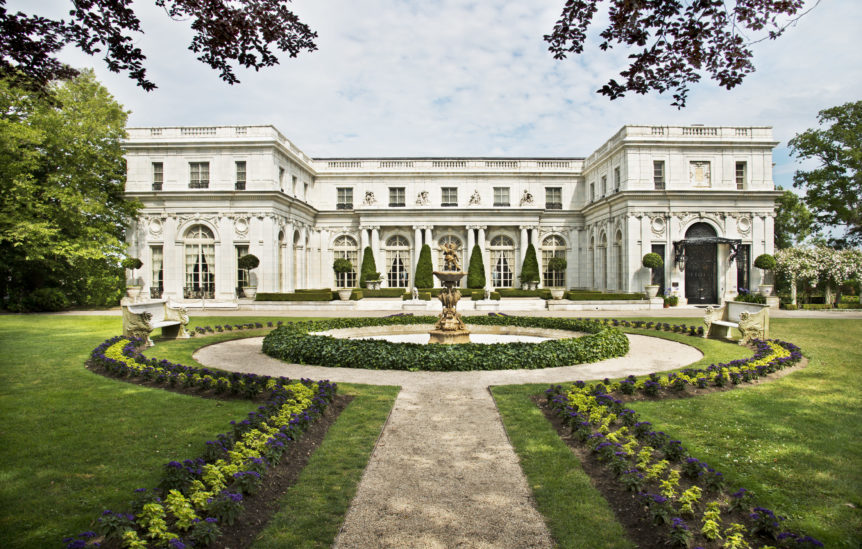In this episode of Curious Objects, Ben Miller takes listeners on a virtual tour of the suite of Gilded Age mansions built for the Vanderbilts, Oelrichs, Astors, and Berwinds in Newport, Rhode Island, by the likes of Richard Morris Hunt and Stanford White. These houses—referred to as “cottages” by their nouveau riche owners—have been lovingly maintained by the Preservation Society of Newport County. The organization’s CEO and executive director Trudy Coxe, curator of exhibitions Ashley Householder, and curator of historic landscapes and horticulture Jim Donahue give Ben the lowdown on the almost three hundred years of architectural history preserved here . . . and, of course, the strife and scandal that stalked the lives of the houses’ owners (spoiler: murder and rosarians’ shenanigans figure into the chronicle).
Trudy Coxe: You feel that authenticity when you walk through the door of any of our houses. They are not manufactured to look like the colonial or Gilded Age. They are real. And I think that’s what makes Newport really special.
Benjamin Miller: Hello, and welcome to Curious Objects & the stories behind them, brought to you by The Magazine ANTIQUES. I’m Ben Miller, and our curious object, so to speak, isn’t really an object at all—it’s the town of Newport, Rhode Island. I’m going to take you on an adventure through the ambitious architecture, lavish interiors, and the very eccentric lives of the Newport elite. During this episode you’ll hear from official audio guides, docent-led tours, and even from some touring companions of mine. As always, there are pictures online at themagazineantiques.com/podcast, and, also, on my Instagram @objectiveinterest.
Today’s episode is sponsored by Freeman’s, America’s oldest auction house, located in Center City, Philadelphia. And we have another sponsor: Reynolda House Museum of American Art, in Winston-Salem, North Carolina.
The Preservation Society of Newport County is a nonprofit which manages eleven historic properties and eighty acres of landscapes in Newport, Rhode Island. Their historic sites last year attracted over a million visitors. Of the properties under their care, the most well-known are those dating to the Gilded Age in the late nineteenth century when Newport became home, or at least a second home, to a prodigious array of American aristocracy: Astors and Vanderbilts summered here, Edith Wharton’s 1921 novel The Age of Innocence paid tribute to it, and Newport was for a time synonymous with high society, class, and wealth. I’m speaking today with Trudy Coxe, the CEO and executive director of the Preservation Society, Ashley Householder, curator of exhibitions, and Jim Donahue, curator of historic landscapes.
Trudy, I mentioned the Vanderbilts, but who were some of the most prominent families?
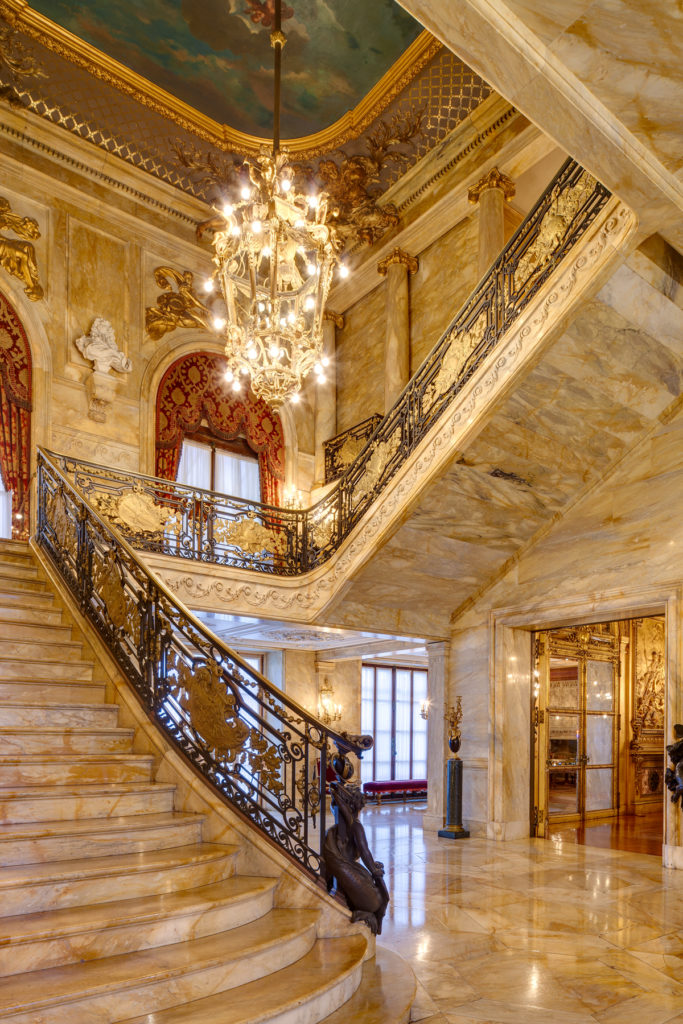
The foyer of Marble House, designed by Richard Morris hunt for William K. Vanderbilt and his family and built between 1888 and 1892. All images courtesy of the Preservation Society of Newport County.
Trudy Coxe: Certainly, several branches of the Vanderbilt family, who built the Elms and Marble House and Rough Point. You had the Berwind family, Philadelphians who ended up building the Elms. There was the Wetmore family that had been around for a good period of time—settled here in the 1850s and 1860s—and then held onto the house that they built, Chateau-sur-Mer, for another hundred-plus years. Much of the collection of Kingscote, a house built in the 1840s, much of that is 100 percent related to the house, so, we’re very fortunate that nothing really had to be brought in to furnish it. So, a lot of names like that. They were hiring the best architects in the world and they were building the biggest summer cottages. Remember, they were only here for six to eight weeks every year but they were building the biggest and the best and they were trying to make the statement that this was the place to be, and, frankly, it still is the place to be.
Benjamin Miller: Let’s hop into Alva Vanderbilt’s so-called “cottage,” Marble House.
And what happened during the Civil War?
Trudy Coxe: Well, what happened during the Civil War depends on where you were in this country. If you were a middle- to upper-class Southerner, it was not unusual for you and your family to head to Europe, primarily Paris, and this is how Alva Vanderbilt, who is the person responsible for Marble House, got her start. Her family escaped to Europe, to Paris, and there, as a young girl, she learned everything French: she learned about French architecture, she learned the language, she learned the art, and when she and her family came back to the United States after the Civil War, in her mind was a French aesthetic. And, so, when she married William Vanderbilt and he gave her that magnificent gift of building a house for her thirty-ninth birthday, she hired Richard Morris Hunt and together they decided that they would model Marble House after the Petit Trianon at Versailles. So, many people from the South were heading to Europe and gaining a European taste to bring back to the United States.
Benjamin Miller: Could you tell me a little bit about the sorts of objects that these people filled their homes with?
Ashley Householder: So, certainly, the best of the best.
Benjamin Miller: That’s Ashley Householder, curator of exhibitions:
Ashley Householder: The Wetmores certainly were world-class travelers and took an extended trip to Europe for a number of years, and they were great collectors, buying the best that Europe had to offer in terms of porcelains and glassware. There’s a Lyon Mercat suite of furniture at Chateau that we’re very proud of.
Benjamin Miller: And was it all European, or were there also, American sources, Asian sources?
Ashley Householder: Really, only European. They were emulating European royalty, so, they would go on their Grand Tours and bring back the best of the market to showcase their wealth and to show neighbors and friends that they were world travelers.
Benjamin Miller: So, was there any thought to the fact that Newport was in fact this crucible of early American craftsmanship, where some of the great early American decorative arts originated, or did that enter into anyone’s thinking?
Ashley Householder: I think during the Gilded Age it was a different aesthetic. They were building these enormous, gorgeous palaces to emulate what was happening in Europe. So, I do feel that when the Vanderbilts and Berwinds were setting up shop they were more interested in European decorative arts.
Benjamin Miller: Because that was an indication of class, style, and sophistication?
Ashley Householder: That’s right.
Benjamin Miller: Ever wondered about the muses who inspired your favorite artists, or how to start your collection of rare books? Freeman’s, America’s oldest auction house, has been telling the story of curious objects and collections since 1805. Discover Pennsylvania’s craft legacy, go behind the scenes at auctions and exhibitions, learn the science behind colored diamonds, and find out who really owns graffiti. From modern masters to French furniture, Freeman’s brings you the inside story, delivering the latest in art market news and events. I strongly recommend that you sign up for their biweekly newsletter, which you can do at their very spiffy website, freemansauction.com. The newsletter brings all these stories and knowledge and more to your inbox. Visit Freeman’s at freemansauction.com to learn more.
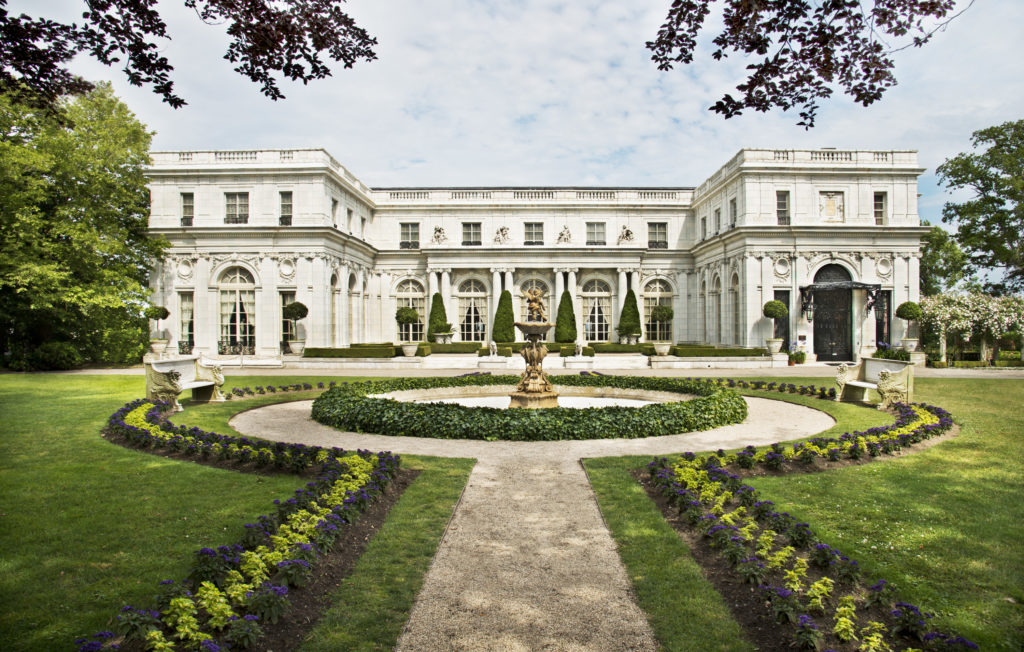
Rosecliff, designed by Stanford White for Theresa Fair Oelrichs, completed in 1902.
Now, I have a personal interest in the aesthetic movement, and we actually handle silver from this period at the firm Shrubsole, where I’m director of research. So, I was intrigued by the current exhibition, curated by Ashley, called Bohemian Beauty: The Aesthetic Movement and Oscar Wilde’s Newport. It’s on display until November 4, so, you do still have time to go see it, on the upper floor of Tessa Oelrich’s mansion, Rosecliff.
This exhibition that’s going on right now . . . Towards the end of the nineteenth century, this movement that we call the aesthetic movement took hold in America, with influences from across Asia and new ideas about incorporating nature into art, decorative arts, etc., and Newport was no exception to the interest in this movement. I’m hoping you can tell me a little bit about what the aesthetic movement meant for Newport, and how on earth that relates to Oscar Wilde.
Ashley Householder: Yes, it’s an interesting story and we’re enjoying having the exhibition at Rosecliff because it does incorporate three of our other properties. We’ve discussed Chateau-sur-Mer, Kingscote, and then the Isaac Bell House, which was built in 1893. As we discussed earlier, Chateau and Kingscote were these earlier properties, but then each family decided to make some renovations, adding whole other wings to the houses. With Kingscote, that happened in 1880–1881, and Chateau in the late 1870s. So, again, these families had the opportunity to really incorporate any sort of furnishing plan or design, or hire any architect that they wanted, and they chose to redesign them in the aesthetic style. And then, the Oscar Wilde connection is interesting because, as you may know, he came on his great North American lecture tour in 1882, which began in New York, and he was already the face of the British aesthetic movement by the time he came here.
Benjamin Miller: Ashley and I walked through the rooms of Rosecliff, seeing beautifully handcrafted works of jewelry, furniture, silver, ceramics—alongside mementoes of Oscar Wilde’s visit to Newport in 1882. This was actually part of a national tour which took the twenty-seven-year-old Wilde across and around the country for eleven months.
How well-known was Oscar Wilde in America in 1882?
Ashley Householder: Well, he was a poet back home and certainly hadn’t written anything yet that we know him for today, but he was a celebrity that people were curious about, so, his fame had preceded him. I think people came to hear him speak more to really catch a glimpse of him and see what he was all about, more than really hearing his thoughts on decorative art or the English Renaissance, which were his two canned lectures when he came.
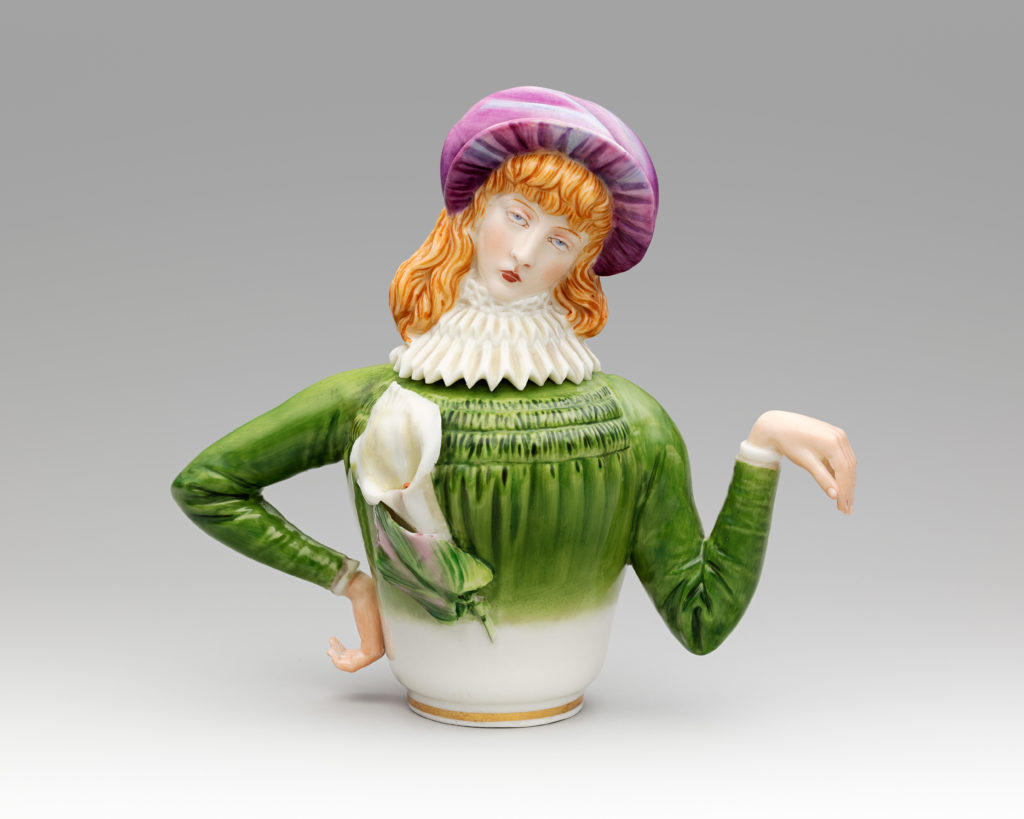
Teapot designed by James Hadley (1837-1903) for Royal Worcester Porcelain Company, 1882. Glazed and enamel parian ware. The Art Institute of Chicago, Eloise W. Martin Acquisition Fund; restricted gift of Maureen Savaiano, Jamie Maloney, Mr. and Mrs. James Knox, and Mr. and Mrs. Terry, Perucca.
Benjamin Miller: What did he have to say about decorative arts?
Ashley Householder: Well, there are these great accounts of his talk here in Newport, and he spoke at the Casino Theatre on July 15, and there are wonderful newspaper accounts of who was in attendance. He was written about in every newspaper in every city he visited, and his tour was also being covered back home in Ireland. He really was proselytizing for Americans to lead a more beautiful life and to surround themselves with beautiful objects. He talked about seeing commuters in New York beaten down on the train and not taking enough time out of their daily lives to enjoy beauty.
Benjamin Miller: Imagine that.
Ashley Householder: I know, nothing has changed! What would he say today?
Trudy Coxe: Good message, though, good message.
Benjamin Miller: I’m sure that didn’t fall on deaf ears in Newport.
Ashley Householder: And the Vanderbilts came in late, Cornelius and Alice Vanderbilt, who of course would go on to build the Breakers. I like to think that some of Oscar Wilde’s message of aestheticism inspired him or influenced his home decorating.
Benjamin Miller: One thing Oscar Wilde would have found eminently familiar in Newport was the gardens—elaborate, expansive, manicured lawns in various styles but certainly reminiscent of English country estates. No one knows more about these gardens than Jim Donahue.
Jim, we’ve talked about Newport as a place of refuge, and there’s no refuge like the refuge of a curated garden. Tell me a little bit about the land that these homes were situated on and their significance.
Jim Donahue: Well, much like their homes, the residents of the summer cottages extended their want for European environs out to their landscape. So, we have landscapes that are very much like the Elms, which are a mix of Italian and French and all European styles mixed together, and they were meant to grant instant heritage to the people who lived there. Not every property we have is strictly neoclassical. Chateau-sur-Mer is picturesque in the English style, and the Breakers is a mixture of picturesque and neoclassical, so, we have a range that represents how the landscape garden evolved from the mid-nineteenth century through the early twentieth century.
Benjamin Miller: Alongside the landscape design, there was actually some creative botany going on?
Jim Donahue: Quite a bit! Aquidneck Island from colonial days was known to be a great nursery area because the Gulf Stream comes close to the southern tip of the island. We have a very long growing season. I live north of here and the growing season there is much shorter than it is here, the weather is always different here. So, we had vineyards, we had nurseries from the eighteenth century, but during the Gilded Age it really became a hub of plant collecting. During the eighteenth and nineteenth centuries a lot of exploration went on in Asia and new plants were shipped back to America and all of our summer cottage residents were collecting plants just as they did art work or China or anything else that they coveted.
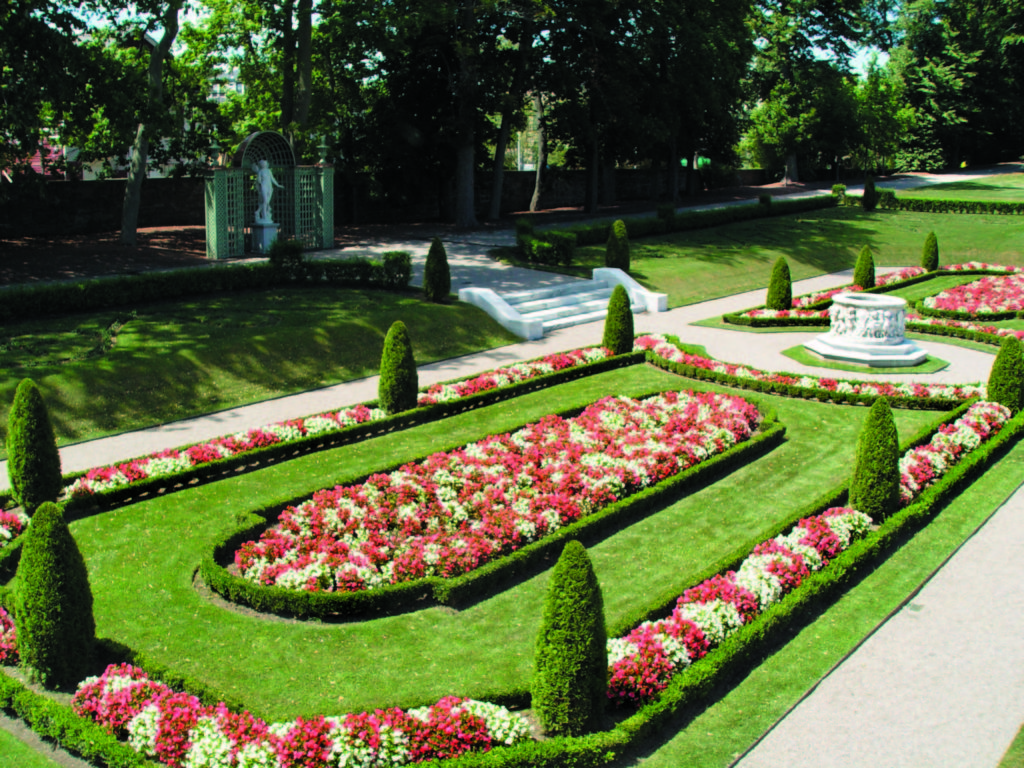
The Elms’ recently-restored sunken classical revival gardens.
Benjamin Miller: Tell me about George Bancroft and his roses.
Jim Donahue: Well, how much time do you have? George Bancroft was truly a character. He was one of the premier historians of the nineteenth century. He wrote a ten-volume treatise on the history of the United States. But his avocation was really roses, and he picked up this hobby when he was in Europe as an ambassador. He was a very close friend of Kaiser Wilhelm, who was a maniacal rose collector, and Kaiser Wilhelm gave him many roses to start.
Benjamin Miller: There was a bit of drama in Bancroft’s life, or around Bancroft’s life . . .
Jim Donahue: Well, there was in more than one way. You’re referring to the American Beauty rose? That’s a long story as well. For the longest time we had attributed the American Beauty rose to being discovered and/or bred at Rosecliff, which turns out not to be the case. It actually was a product of his Washington DC gardener, who had been given the challenge by Bancroft to come up with the first red hybrid perpetual rose that could be grown under glass, because at that time you couldn’t have roses in winter that were red. They just didn’t exist. So, Bancroft gave that challenge to his Washington DC gardener and somehow a French rose was renamed the American Beauty rose and was marketed as the American Beauty rose. We don’t know if it was mislabeled or his gardener was trying to pull a fast one, but when Bancroft died the gardener had the four original American Beauty roses—they had not yet been commercially propagated—and his wife sold them for a pittance to a grower in Maryland without his knowledge. And he lost all rights to the American Beauty rose. He ended up on the streets. It was a really sad story.
Benjamin Miller: I promise I’ll get away from Bancroft in just a second, but I also want to get into the sordid details of the Parkman murder.
Jim Donahue: Oh, wow. How do you know that?
Trudy Coxe: We try to keep that a secret around here!
Benjamin Miller: Heading into dangerous territory. This was a little grizzly.
Jim Donahue: This was a little grizzly and, you know, it wasn’t . . . I had been looking at the Newport atlas, trying to figure out what the original layout of the Bancroft rose garden was, and in the 1876 Newport atlas it showed a plot of land in front of Rosecliff, fronting Bellevue Avenue, that said “Eliza Parkman of Boston.” No other women were listed on this deed, and I thought that was interesting but I also knew the name Parkman because of Francis Parkman and I thought, “well, it can’t be the same Parkman.” And, so, I started to read into it a little bit, and it turns out that Eliza Parkman was Francis Parkman’s aunt by marriage. Francis Parkman was the premier rosarian in the United States during the nineteenth century. He also was a Harvard historian, like George Bancroft. They were colleagues. Bancroft was Parkman’s mentor in terms of his history research, but Bancroft also promoted Parkman’s research into roses. To make a long story short, Parkman’s uncle was the victim of a notorious murder at the Harvard Medical School, by Professor Webster, who was a chemist and chemical professor. Dr. Webster owed Mr. Parkman the elder about $4,000. It was money with interest. At that time that would have equaled about $60,000-plus.
Benjamin Miller: Not nothing.
Jim Donahue: Not nothing. So, it was a day before Thanksgiving, 1849. Mr. Parkman went to see Mr. Webster and demand payment, Mr. Webster panicked and killed him and dismembered him and burned his body in the lab.
Benjamin Miller: Is that all?
Jim Donahue: His body was found in the privy of Harvard Medical School by the janitor and the only way they were able to identify his body was by a pair of nineteenth century dentures. This was the first American case that used forensic evidence to convict someone.
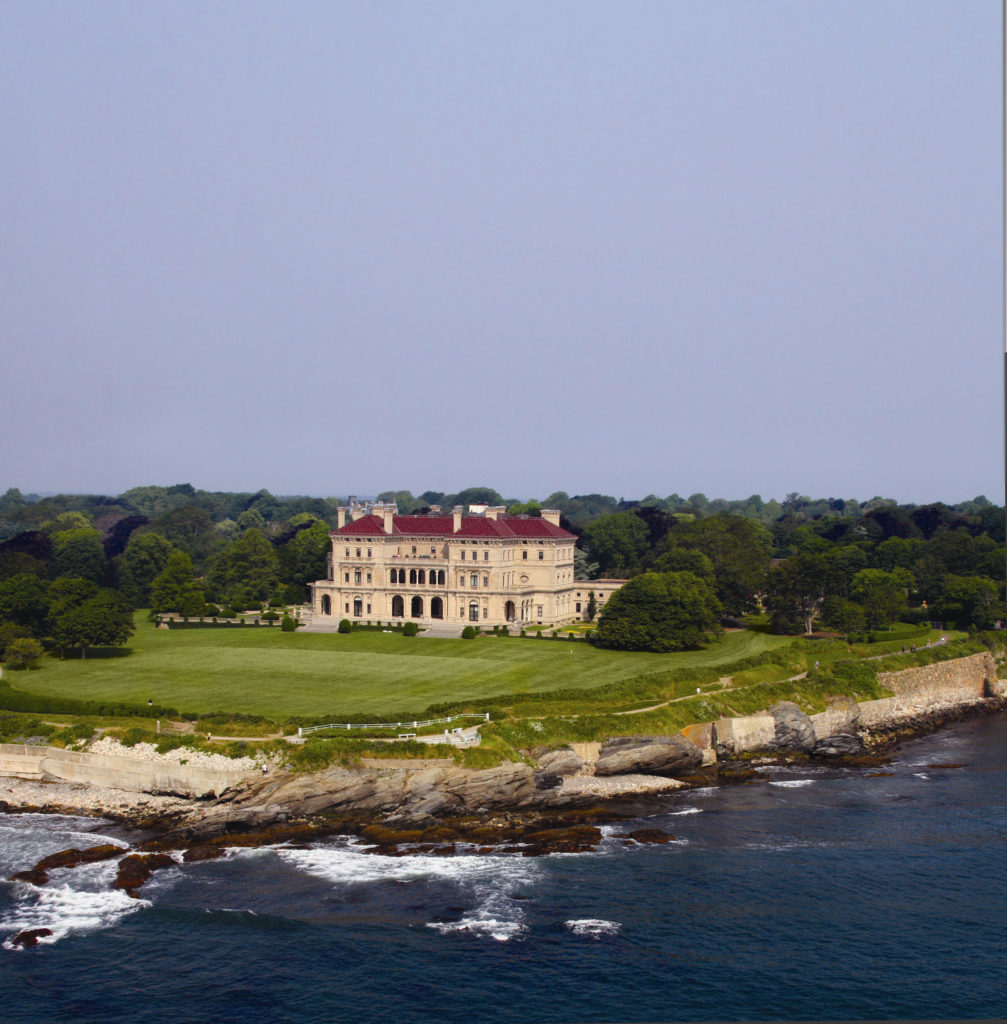
East façade of the Breakers. Cornelius Vanderbilt II commissioned Hunt to design the Italian Renaissance–style palazzo in 1893. The building was completed in 1895.
Benjamin Miller: Ok, so, that story wasn’t strictly about Newport, but I couldn’t resist adding a wonderfully gruesome episode like that to the podcast. On that note, I want to take a minute, as I do every episode, to thank you very much for listening. If you like what you’re hearing, spread the word! A great and easy way to do that is to leave a rating and a review on iTunes. Or tell a friend or colleague about Curious Objects! As always, I love hearing your feedback, so, please send me an email with your thoughts, comments, and suggestions to podcast@themagazineantiques.com. Or connect with me on Instagram @objectiveinterest.
Our second sponsor for this episode is Reynolda House Museum of American Art, in Winston-Salem, North Carolina. Reynolda House is more than just an elegant 1917 historic estate. It’s also home to a compelling and surprisingly wide-ranging collection of fine and decorative arts. Now, if you listen to this podcast, you probably already like house museums. But Reynolda House goes beyond the typical displays of period furniture and old portraits. When you visit, you’ll find thought-provoking objects like American artist Martin Johnson Heade’s most famous orchid and hummingbird painting, tobacco baron R. J. Reynolds’s mink coat, and century-old farm buildings now serving crepes and rosé. For any other museums out there listening, let me just say that this is a great idea. They also have a brand-new app you can download called Reynolda Revealed, which takes you on a virtual tour of the museum and grounds. I downloaded that myself and had a lot of fun with it—I highly recommend checking it out at reynolda.org, and, of course, planning your visit to the house in Winston-Salem, North Carolina. That’s r-e-y-n-o-l-d-a.org.
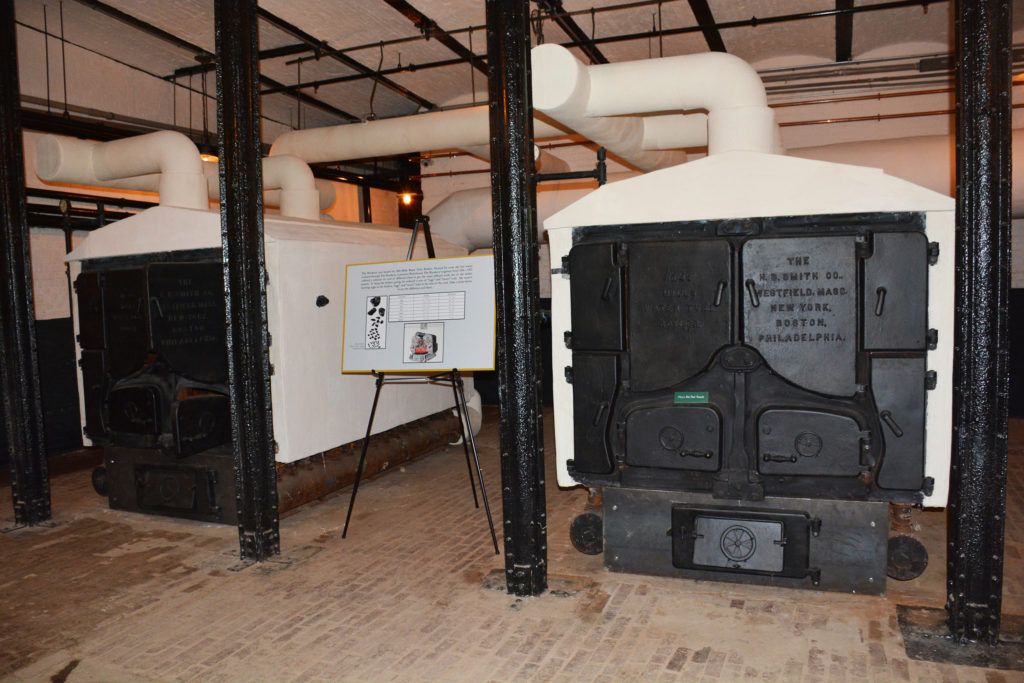
The Breakers’ boiler room.
Benjamin Miller: You’ve recently undertaken a restoration of the boiler room, in sort of the underbelly of the Breakers. What for? What did you discover during that restoration process?
Trudy Coxe: When the first Breakers burned down and Cornelius Vanderbilt was planning the second house in 1892, his main emphasis was to separate the boiler from the house. That was paramount in his planning for the building. And, so, the boiler room is three hundred–plus feet away from the house, under a cottage, that, for all intents and purposes, is a cottage that hides a chimney from the boiler room. That’s really what it is. It’s at the front gates of the Breakers. The boiler room was in very bad shape. It flooded all the time and every one of the beams was rusted out, but we thought it would be a pretty interesting room to see, and an interesting story, and we began to think: wouldn’t it be fun to take people from the boiler room through that tunnel and then take them through the basement?
You know, when you think about it, back in 1895, how did the heat get into all seventy rooms? How did you get water to all the bathrooms and the kitchen? How did the elevators work? It’s an interesting technology story. I think it’s so amusing that we found a letter that Cornelius Vanderbilt wrote to many of his friends saying, “I’ve heard about this man named Thomas Edison, and I’ve heard about this new thing called electricity, and I think it might be valuable if we would all get together and meet with him and learn more.”
Benjamin Miller: Now, the infrastructure supporting the operation of these mansions wasn’t just mechanical and technological. The most important support, of course, was the enormous staff dedicated to making each house and each party run smoothly. And any discussion of the Gilded Age has to acknowledge the chasm between the lifestyles of the elite and those of the people who served them—not to mention the workforce whose labor built the wealth of these powerful families. It doesn’t take too much imagination to find parallels between their economic times and ours.
I want to talk a little bit about the social and socioeconomic dynamic that’s happening at this time, because the Gilded Age was a period of civil unrest and strife, with riots in New York and elsewhere, and labor disputes leading to violent confrontations around the country. How did life in Newport relate to that struggle, that dynamic? Was Newport a refuge for the elite from that kind of difficulty, or did some of that seep through the cracks here as well?
Trudy Coxe: It was absolutely a refuge, except for the fact that Mr. Berwind did face a strike by his staff at the Elms, where they all walked out on him because they were unhappy with the working conditions. Imagine, in Newport during the height of summer, there was a lot of entertaining. Every night there was a party somewhere. Somebody was having a dinner, somebody was having a dinner dance, your whole day was filled with recreation, from morning tennis to swims at Bailey’s Beach, to getting on a coach in the afternoon with four horses pulling you along, showing off your finery. It must have been an exhausting period of time for those who were partaking, but, also, for the workers. But, in general, this was a place where you could get away from the world-weary world and enjoy yourself. That’s how they were living their lives. That strike at the Elms didn’t last very long, he just brought in a whole new team of people and kept going on.
Benjamin Miller: That was easy, huh?
Trudy Coxe: Yeah! The other thing is that from an economic perspective, these families were hiring a lot of local people for fairly short periods of time. So, their work for the family, for maybe two months maximum, probably paid for the whole year. I guess there was a weighing in the minds of people who were working for the families that—even though, yes, New York was a different place, and, yes, Chicago is a different place—that I have to sow while the sun is shining, this is when I’m going to, you know, make things good for my family for the rest of the year. So, there may have been a dynamic amongst the workers here that said, “we’re just going to work even if we’re unhappy.”
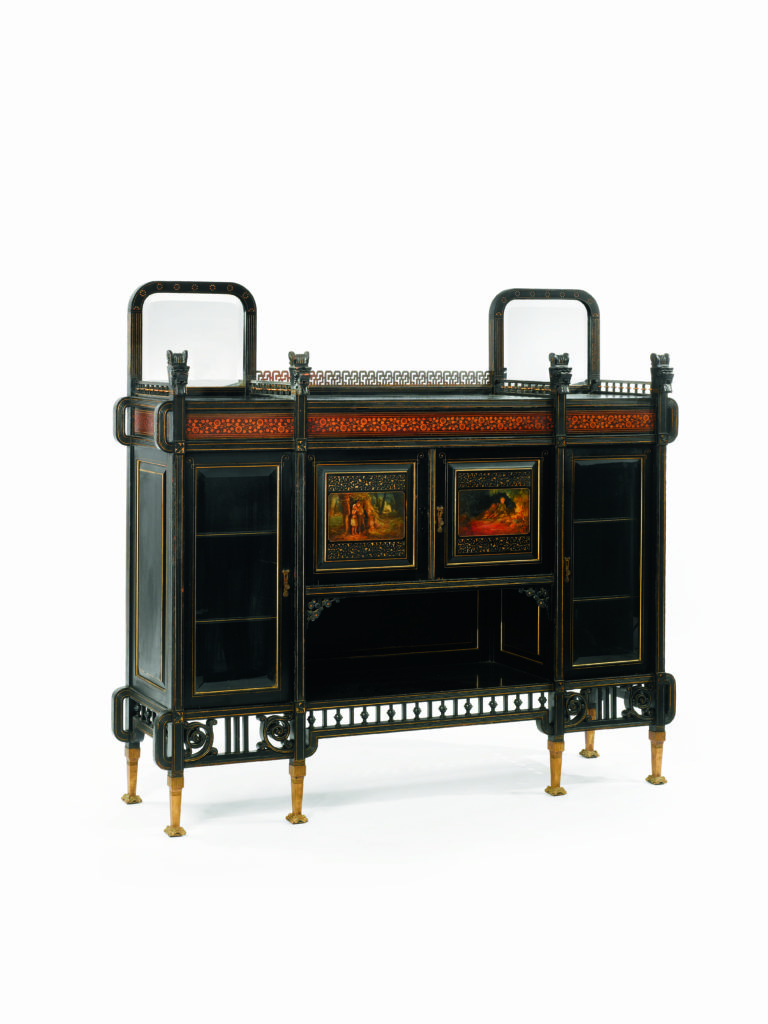
Cabinet by the Herter Brothers, 1875. Ebonized and parcel-gilt wood, marquetry, painted panels, gilt-metal and glass. The Richard H. Driehaus Museum; photograph courtesy of Sotheby’s, Inc. © 2009.
Benjamin Miller: Well, that’s one possibility. My friend Zack Mitchell had another idea.
Trudy, how is it that many of these great mansions have now come to be museums, rather than homes for today’s 1% or .1%?
Trudy Coxe: The history of the organization and how we have acquired all eleven properties is really a fascinating one, because it started in the 1940s when a colonial house down on the waterfront, Hunter House, was really in distress and the rumor around town was that the magnificent panels from the interior of the house were going to be taken out of the house and reinstalled at the Met. Some people say this story is not true. People from the Met say it’s not true. We all say it is true. And a group of people, primarily women, rose up and said those panels are Newport’s heritage. They don’t belong anywhere else. And the way to save them would be to save the house. So, they went on a campaign and bought Hunter House. But Hunter House at that point had no furniture, and it also needed a tremendous amount of work to be preserved. So, the next campaign was to begin to restore the house. And of course there wasn’t a whole lot of money around, so, Katherine Warren, our founder, went on a campaign to get her friends interested in the colonial part of Newport and in the Hunter House specifically, and she entered into an agreement with her very good friend Countess Széchenyi, who owned the Breakers, and who offered to open up the first floor of the Breakers to tours for a dollar and the money raised from those tours would be plowed into the restoration of Hunter House. What a phenomenal thing to do! A great act of philanthropy by the Vanderbilt family (she was a direct descendant, Countess Széchenyi). And, so, she’s now living on the second and third floors and her first floor is open up for tours and that resulted in a lot of interest in Newport in general. And then in the early 1960s Harold Vanderbilt bought Marble House from the Prince family. His family had lived in it previously and sold it to the Princes. He bought it back and gave it to the preservation society, and then Chateau-sur-Mer came along, and other houses came along over a period of time, some of which were given to us, some of which were sold to us. And here we are today with eleven historic houses representing a range from the 1740s all the way through 1902. Every style of domestic American architecture is on view here in Newport, all within walking distance. I think what’s so unique about Newport, as opposed to Sturbridge or Plymouth or Williamsburg—no disparagement meant here at all . . . but every single one of our houses is real. It was houses that were lived in, worked in, and entertained in, and you feel that authenticity when you walk through the door of any of our houses. They are not manufactured to look like the colonial or Gilded Age. They are real. And I think that’s what makes Newport really special.
Benjamin Miller: What have we missed? What should we cover that we haven’t covered? Did we say everything that needs to be said?
Trudy Coxe: We could talk for hours. That’s not a good question to ask us, Ben, because we really could talk for hours!
Benjamin Miller: Well, thank you all so much for joining me. It has been a real pleasure.
All: Thank you.
Benjamin Miller: And thanks again to all of you for listening! I’d like to thank our sponsors once more, Freeman’s Auction House and Reynolda House. And a huge thank you to the Preservation Society of Newport County for making this episode possible. Don’t forget to send me your feedback at podcast@themagazineantiques.com, and don’t forget to subscribe and rate Curious Objects on iTunes or wherever you listen to podcasts. Today’s episode was edited and produced by Sammy Dalati, our music is by Trap Rabbit, and I’m your host, Ben Miller.

Trudy Coxe.
Trudy Coxe is the CEO and executive director of the Preservation Society of Newport County. She oversees a collection of eleven historic house museums, including seven National Historic Landmarks, spanning nearly three hundred years of American architectural history.
.

Jim Donahue.
Jim Donahue is curator of historic landscapes and horticulture for the Preservation Society of Newport County, implementing and managing a program to assure excellence in the restoration, presentation, and public enjoyment of the historic gardens, landscapes and horticulture of the Newport Mansions.
.
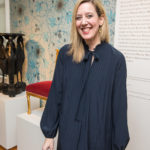
Ashley Householder.
Ashley Householder is curator of exhibitions for the Preservation Society of Newport County and is responsible for developing and producing in-house, borrowed, and traveling exhibitions. Her current exhibition, Bohemian Beauty: The Aesthetic Movement and Oscar Wilde’s Newport is displayed in the galleries at Rosecliff.
.
For more Curious Objects with Benjamin Miller, listen to us on iTunes or SoundCloud. If you have any questions or comments, send us an email at podcast@themagazineantiques.com.

